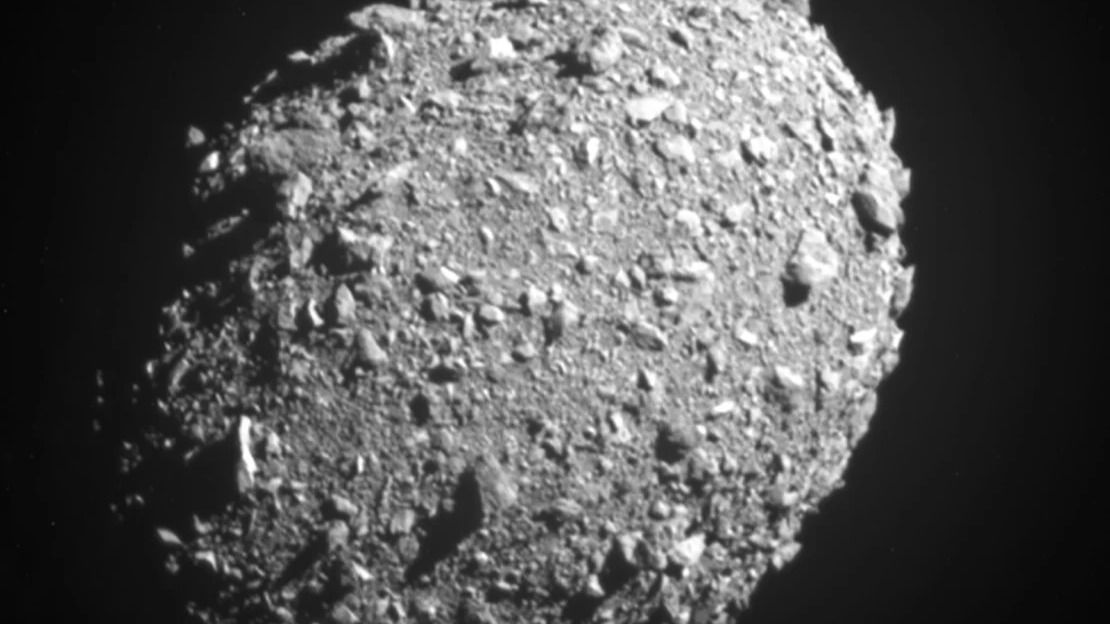A recent investigation into the fallout from NASA’s Double Asteroid Redirection Test (DART) reveals that while debris from the spacecraft’s collision with the asteroid Dimorphos could produce meteorites on Mars, Earth is unlikely to experience a meteor shower.
The DART spacecraft, which struck Dimorphos on September 26, 2022, was designed to test whether a kinetic impact could alter the orbit of a potentially hazardous asteroid. The mission was a success, as Dimorphos was pushed into a shorter orbit around its parent asteroid, Didymos. Neither asteroid posed a threat to Earth; they were simply used for testing purposes.
Observations of ejected debris
The impact created a large crater on Dimorphos and ejected a substantial amount of debris. This material, which was observed by the Light Italian Cubesat for Imaging of Asteroids (LICIACube), was ejected at speeds of up to 500 meters (1,640 feet) per second. LICIACube, which had accompanied DART to capture images of the aftermath of the collision, recorded particles ranging in size from a micron to several centimeters.
Further observations made with the Large Array Survey Telescope (LAST), the 28-inch telescope at Wise Observatory, and optical and ultraviolet instruments on NASA’s Swift satellite suggested that additional microscopic particles were ejected at velocities ranging from 1,400 to 1,800 meters (about 4,600 to 5,900 feet) per second.
Modeling debris spread
A team led by Eloy Peña-Asensio of Milan Polytechnic and Michael Küppers, a Hera project scientist at the European Space Agency, has modelled the possible spread of this debris through the solar system. Their simulations, which took into account the gravitational influences of Didymos, Dimorphos, the Sun and other planets, revealed some intriguing possibilities.
According to their main simulation, which tracked 3 million particles of varying sizes, the slower-moving debris could reach Mars in 13 years, in 2035. This is because the orbit of the Didymos-Dimorphos binary system intersects the orbit of Mars. However, the simulation indicated that none of these particles are expected to reach Earth.
Potential of terrestrial meteorites
The secondary simulation, which took into account higher-speed ejections, suggested that while the fastest particles could reach Mars in five years and Earth in seven, they would be too small to produce a meteor shower visible on Earth. “In our main simulation, no particles reach Earth at speeds up to 1,000 meters (3,280 feet) per second,” Peña-Asensio explained. “Only particles ejected at speeds of 1,500 meters (4,900 feet) per second or more reach Earth, and this occurs exclusively in the secondary simulation.”
However, if LICIACube does not detect larger particles or if they are slightly larger than those observed, it is still possible that some of them could reach Earth and create visible meteors. “Only future meteor observation campaigns will be able to verify this,” said Peña-Asensio.
Origins of the debris
The simulations also identified possible origins of the debris reaching Earth and Mars. Debris that would likely create a meteor shower on Mars would come from the northern part of the impact site, while smaller, faster-moving particles that could reach Earth would originate in the southwestern part of the crater.
Peña-Asensio concluded: “Impacts like DART and the resulting ejections highlight the ongoing exchange of material between planetary bodies, asteroids, comets and other celestial objects.”
So while Earth’s skies may remain free of meteor showers from the remnants of Dimorphos, Mars could enjoy a spectacular display of shooting stars in the next decade.
This research is available as a preprint in the arXiv article repository.
Disclaimer:
The information contained in this post is for general information purposes only. We make no representations or warranties of any kind, express or implied, about the completeness, accuracy, reliability, suitability or availability with respect to the website or the information, products, services, or related graphics contained on the post for any purpose.
We respect the intellectual property rights of content creators. If you are the owner of any material featured on our website and have concerns about its use, please contact us. We are committed to addressing any copyright issues promptly and will remove any material within 2 days of receiving a request from the rightful owner.

